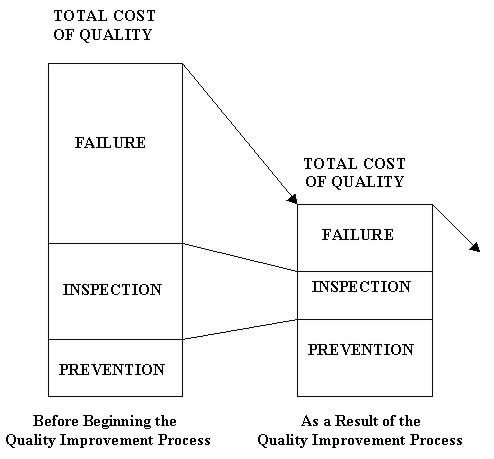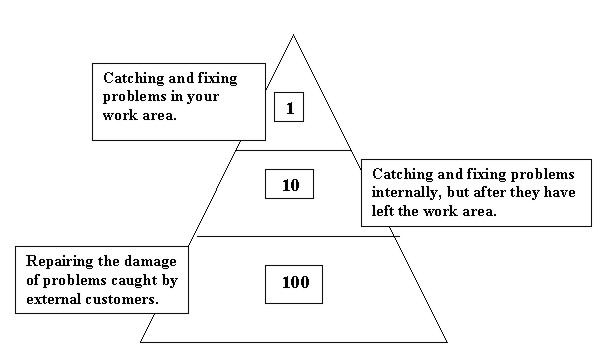QUALITY AND BUSINESS PRACTICESProf. John R PARKER, AustraliaKey words: Quality, Quality Assurance, Customer Service, FIG Charter of Quality, Business Practices. INTRODUCTIONA business that is successful in a competitive market over a long period of time, that has repeat customers must be providing a product or service that meets or exceeds customer needs. If it is meeting or exceeding customers needs it has to be providing a quality product or service and doing it using good business practices. The development of a total quality culture throughout the whole surveying profession should be actively encouraged to provide the principles of best practice and customer service to ensure the future of the surveying industry and the surveying firm. In simple terms we need to ensure we 'get it right first time, every time'. WHAT IS QUALITYQuality can be defined as:
Quality is in the eye of the beholder, i.e. the customer, therefore we need to provide a quality service to satisfy our customers needs. THE COST OF QUALITYIt is not uncommon in a service industry, like the surveying profession, for the cost of achieving quality to be more than 30% of total revenue of a business. The cost of quality includes the costs of prevention, of inspection and of failure. The first step to reducing the cost of quality is understanding that quality costs are not created equal. Rather they can be divided into three distinct categories:
1. Prevention Costs Prevention costs can be regarded as an investment because preventing (as opposed to correcting) quality problems makes the organisation much stronger over time. 2. Inspection and Correction Costs Inspecting and checking other peoples work is a role which virtually all managers and supervisors must fulfil each day. Yet, in most cases, neither the inspector nor the inspected finds this aspect of his or her job gratifying. 3. Failure Costs Quality mistakes that turn up outside the organisation, after the service is delivered to the customer are costs that must be avoided. Your organisation is cast in the worst possible light when it fails to meet your customer's valid requirements. In hard monetary terms, failure is by far the most costly quality problem. The cost of recalling or to 'make good' on a service delivered unsatisfactorily is extraordinarily high.
Figure 1. The total 'cost of quality' reduces as the quality improvement process proceeds, prevention costs increase, while inspection and failure costs decrease. (Acknowledgement to ODI) A good rule of thumb for comparing the relative costs of the three categories in your organisation is the "1-10-100 Rule". For every dollar or hour your organisation might spend on preventing a quality problem, it will spend 10 to inspect and correct the mistake after it occurs. If the failure goes unchecked or unnoticed until after the customer has received the service, the cost of rectifying the failure will probably be 100 times what you could have paid to prevent it from happening at all.
Figure 2. 1-10-100 rule. It makes a difference when a problem is fixed. The 1-10-100 rule shows that if a problem is not fixed when it occurs, it will only become more costly to fix later, in terms of both time and money. (Acknowledgement to ODI) For reducing your Cost of Quality it becomes clear: Invest in prevention. Be sure everyone in your firm understands the true cost of quality. And give your people the practical tools they need to make the 1-10-100 work for, not against your organisation. Ultimately the key goal of the firm and each of its members is to do "right things right". THE CUSTOMER AND QUALITYThe customer can only determine quality. Quality is about finding out what the customer wants at a cost both the customer and supplier are satisfied with. The quality service that ultimately goes to the external customer is dependent on how well the internal customer/supplier process is managed. It is important for everyone in a firm to identify who their customers are and how to keep them satisfied. CUSTOMER SERVICE CHARTERIt is important for staff within a firm to make a commitment to customer service. An ideal way is to develop a customer service charter which has a mission statement, has service objectives, has service commitments, followed by service goals and strategies and service standards. FIG CHARTER FOR QUALITYFIG has adopted a Charter of Quality in which its members recognise and agree to undertake:
It is important that the Charter for Quality forms part of an organisations business practice. QUALITY ASSURANCEA key element of any customer service is how can the customer be assured of the quality of the service supplied. The International Standards Organisation (ISO) has developed a series of standards (ISO 9000 series) which gives the supplier the minimum guidelines to allow the development of an appropriate quality management system which can demonstrate product or service quality assurance to the customer. The latest ISO 9001:2000 version addresses a number of inadequacies in the way quality assurance has been seen in the past. Properly understood ISO 9001 asks organisations to address a number of basic management issues in a manner that is appropriate to the use and nature of the organisation in question. The issues themselves are virtually indisputable in terms of ensuring good service to clients and ongoing health of the organisation. The ISO9001:2000 version is very positive from a surveyors point of view, because as a technical profession, surveyors weaknesses have tended to arise in relation to the broader management controls. Successful organisations have a focus on business planning, communication and the image they project to the community. In a typical surveying practice the 2000 version of ISO 9001 suggests management should:
The 2000 version of ISO 9001 provides an ideal framework for considering, implementing and monitoring the important management issues of any business practice, but it does require time and resources to make it happen. ISO 9001:2000 is a most useful tool to use as a framework for a critical evaluation of a firms organisational processes. IMPLEMENTATIONThe implementation of a quality customer service initiative as part of the road to continuous business practice improvement can be considered in three stages.
CONCLUSIONIn a competitive market place, it is rarely wise to stand still and give competitors the opportunity to race past you. Hence it is worth remembering that Quality is a journey not a destination, and that it is an on-going process that should never end. Using ISO 9001:2000 and having a Customer Service Charter as part of standard business practice provides an ideal framework to demonstrate to customers that the organisation does value its customers and wants to provide the best service possible. REFERENCESMcCarthy P.M., May 1992, 'Total Quality Management - The Customer and TQM' - Traverse Issue 122, P10, Melbourne, Institution of Surveyors Australia, Victoria Division. Morgan Consulting Group, 1995, 'Customer Service Commitment Charter' - Department of Treasury and Finance, Melbourne, Australia. Parker J., February 1992,'Quality Management - The Cost of Quality' - Traverse Issue 121, P15, Melbourne, Institution of Surveyors Australia, Victorian Division. Parker Prof. J., 2000, 'Quality Awards and Surveyors', FIG Working Week, Prague, Czech Republic. Sippel P. & Crellin K., 1991, 'Aim for Perfection' - Association of Consulting Surveyors, Deakin, Australia. Standards Australia, 1999, ISO 9001(Int):2000, Quality management systems - Requirements, Interim Australian/New Zealand Standards. Wood S., 2000, 'QA The Great Survivor', Measure & Map Issue No. 11, Alexandria, Australia. BIOGRAPHICAL NOTEProfessor John Parker is an international land administration consultant specialising in quality management, professional practice and management and geographical names. He was Surveyor General of Victoria in Australia for nine years and had spent nineteen years in private practice in a multi disciplinary firm. Currently he is actively involved in the International Federation of Surveyors and is chair of FIG Commission 1 (Professional Standards and Practice). Membership of professional associations includes the Institution of Surveyors Australia. Papers have been presented and published at a range of events, including international forums, on a wide range of subjects. CONTACTProfessor John Parker 17 April 2001 This page is maintained by the FIG Office. Last revised on 15-03-16. |

